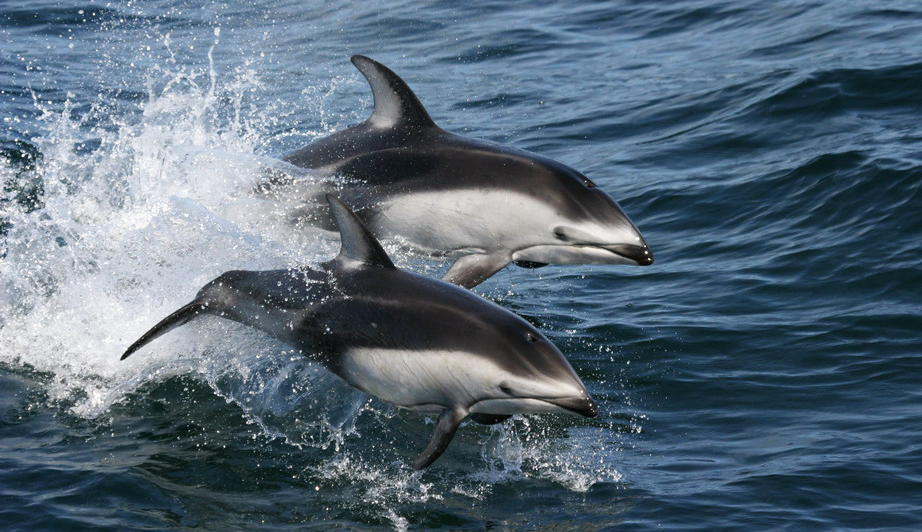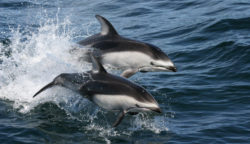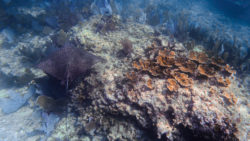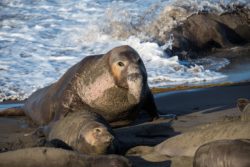
A Look into the Wintertime at our National Marine Sanctuaries
You won’t find ski slopes or ice rinks in America’s National Marine Sanctuary System this winter, but that doesn’t mean there is a shortage of things to do. In fact, the cooler months mark the start of some incredible natural events worth seeing and the best time of year for some notable outdoor recreation opportunities. It doesn’t hurt that most of these sanctuaries are in warmer climates, perfect for anyone looking to escape colder winter temperatures. Here are some of our favorites:

Pair of Pacific white-sided dolphins in Cordell Bank National Marine Sanctuary. Photo: Michael Richlen/NOAA
Cordell Bank (California) – Beginning in late-October and lasting throughout the winter, pods of thousands of Pacific white-sided dolphins gather off the coast of northern California. While the Pacific white-sided dolphin is the most frequently sighted marine mammal in the sanctuary, catching a glimpse of a superpod is a rare and lucky find! The sanctuary is home to one of the most productive upwelling sites in the ocean, which makes it a popular feeding destination for many other marine mammals.
Channel Islands (California) – The winter months in southern California are excellent for tide pooling because afternoon low tides expose marine algae and vertebrates. The low annual tides begin around November and lasts until February. The warm weather, gentle breezes, and calm waters make the waters around the Channel Islands perfect for snorkeling, kayaking, and diving. Make sure to keep an eye out for Northern elephant seals as well! Their breeding season begins in December and they are often found around the Channel Islands.
Florida Keys (Florida) – Warm weather, pristine waters, and a slower way of living make the Florida Keys a popular winter destination for visitors from all over the world. Manatees are a common sight in Keys waters as they seek warmer areas and aquatic vegetation to graze on. In the late fall, small feeder fish move into the sanctuary from northern waters and attract game fish species like sailfish and king mackerel, which stay in the sanctuary through the spring.

Spotted Eagle Ray at Pickles Reef in Florida Keys National Marine Sanctuary. Photo: Andrew Ibarra
Flower Garden Banks (Texas) – Spotted eagle rays, hammerhead sharks, and other species migrate from the Atlantic to the Gulf of Mexico in early December and stay until about February. These are an incredible sight to see along with the vibrant coral reef ecosystems that lie beneath the sanctuary’s waters all year long.
Gray’s Reef (Georgia) – The Northern Atlantic right whales leave Stellwagen Bank National Marine Sanctuary in October and arrive to the waters off the coast of Georgia and northern Florida in November. These waters, including those near Gray’s Reef National Marine Sanctuary, serve as critical breeding grounds for this endangered species. It is possible to see right whales along with other marine mammals and sea turtles in the sanctuary through the early spring. If you go wildlife viewing, remember your ocean etiquette!
Greater Farallones (California) – November marks the final month of peak great white shark sightings off the South Farallon Islands and gray whales – with pregnant females leading the pack – migrate through the sanctuary in December and January. Whale watching tours are common, but you can also see them from land at these locations.

Northern Elephant Seals in Monterey Bay National Marine Sanctuary. Photo: Robert Schwemmer
Hawaiian Islands Humpback Whale (Hawai’i) – Not surprisingly, humpback whales are abundant in the Hawaiian Islands in the winter. They arrive in December and stay until the early spring. Tourists and locals alike have the opportunity to assist with humpback whale research as part of the annual Sanctuary Ocean Count, which takes place on the final Saturday in January, February, and March.
Monterey Bay (California) – Northern elephant seals arrive to their breeding colonies in late November, with adult males arriving first to fight for dominance and prepare for females to come to shore. Pupping season begins in late December when females arrive and lasts through February. Several beaches in the sanctuary like Big Sur provide elephant seals with areas to rest and socialize, making elephant seal viewing a popular activity in the area.
For fans of birdwatching, hundreds of thousands of wintering waterfowl – ducks, geese, and other birds – rest and feed in the lagoons and estuaries in the northern portion of Monterey Bay on their way south.
To see a monthly list of natural events that occur in the National Marine Sanctuary System throughout the year, click here.
